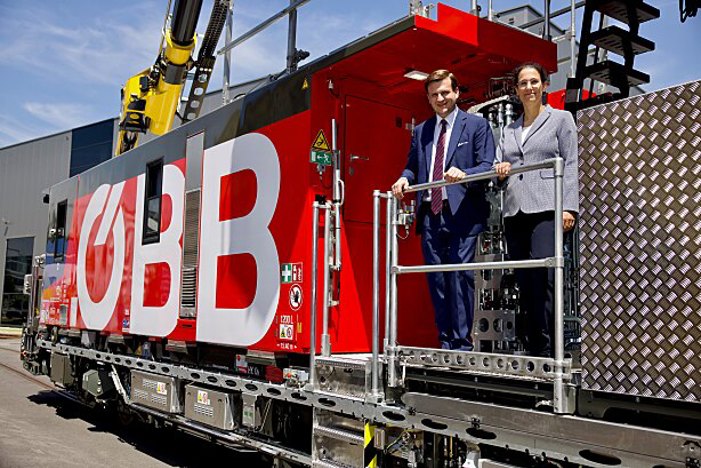Currently, ÖBB produces around 970 GWh of renewable energy in-house, but it now plans to add an additional 800 GWh of green power. As a result, the firm noted that the self-sufficiency of ÖBB’s operating facilities will increase from 11% to 67% and energy efficiency will increase by a further 25%.
For more than 100 years, ÖBB has pioneered the use of electric power for sustainable mobility. In its early days, ÖBB phased out coal and built the first hydroelectric power plants for traction current. Today, eight of the company’s own hydroelectric power plants form the backbone of ÖBB’s energy production.
In 2015, meanwhile, ÖBB commissioned the world’s first 16.7 Hz traction current solar power plant in Wilfleinsdorf in Lower Austria. In addition, the world’s first photovoltaic system for green traction current was piloted on a noise barrier in Tullnerfeld. Today, ÖBB operates a total of 68 PV systems. Furthermore, last year ÖBB unveiled the world’s first traction wind turbine.
In a statement about the new energy strategy, ÖBB noted, “It can be assumed that the demand for green electricity will increase sharply in the coming years. To achieve the ambitious goals of the ÖBB energy strategy, environmentally friendly electricity production and energy efficiency will be increased, thus further increasing the company’s own energy supply from renewable sources.
“All of this contributes to the energy autonomy of the entire domestic railway operation in order to become even more independent of irrational – and international – price fluctuations and supply bottlenecks in the future,” it added.
Austria’s climate protection minister Leonore Gewessler and ÖBB CEO Andreas Matthä jointly presented the new energy strategy yesterday (June 5) in front of the 6,000m² photovoltaic system for green traction current in Kottingneusiedl, Lower Austria.
Gewessler said, “ÖBB’s energy strategy shows how the energy transition is worthwhile in the company on many levels. The self-produced electricity from renewables can be used locally, which strengthens independence and makes energy cheaper. Photovoltaics plays a major role in the energy transition. With its PV systems, ÖBB is demonstrating how space can be used sensibly twice. I look forward to seeing many companies follow suit.”
ÖBB’s Matthä added, “Our energy strategy enables us to achieve one thing above all: more self-sufficiency and independence. As one of the largest climate protection companies in Austria, we will invest around €1.6 billion in alternative forms of energy and our energy efficiency by 2030. In this way, ÖBB combines the energy transition and mobility transition into a coherent whole.”
Sustainable maintenance

Last week, ÖBB also presented the first of 56 new emission free maintenance vehicles from Plasser & Theurer. ÖBB-Infrastruktur, ÖBB’s infrastructure and planning division, has invested more than €250 million in new high-tech hybrid vehicles from Plasser & Theurer to replace diesel-powered maintenance vehicles.
Plasser & Theurer will provide 21 Plasser MultiCrafters for track maintenance, 29 Plasser CatenaryCrafter for overhead lines, repair, and assembly, and six Plasser TransportUnits. A purchase option has been agreed for a further 46 vehicles.
The vehicles use E³ drive technology, which uses overhead line power and battery power, enabling machines to be operated free of any exhaust emissions. Furthermore, a newly developed modular design is based on a uniform carrier vehicle, which is designed in three variants for specific tasks.
The first vehicle in the series, a Plasser CatenaryCrafter 15.4 E³, is now undergoing extensive testing on Austria’s rails. The CatenaryCrafter has a long-reach railway crane and thus ensures a safe stand and a protected working environment for employees even in very exposed places. Thanks to the three-part aerial work platform, which is installed centrally on the machine, it is possible to work in three different positions at the same time.
An integrated social area and a workshop area also ensure that personnel do not have to leave the secure space of the vehicle. The CatenaryCrafter can accommodate up to 11 people, who are sheltered during the transfer trip.
Speaking about the ÖBB contract, Johannes Max-Theurer, CEO of Plasser and Theurer, said, “For us, the new ÖBB fleet represents the largest single order in the 70-year history of Plasser & Theurer. We are particularly pleased with the decision to equip all vehicles with our E³ technology, as this will further strengthen the most sustainable transport system – the railways.”
Judith Engel, member of the board of management at ÖBB-Infrastruktur AG, added, “For us, the machines are an essential tool for the maintenance of overhead lines, track, and superstructure. They also play an important role in the construction of new overhead lines, during inspections or for rapid intervention in the event of a malfunction. The new fleet is powered by electric drive instead of diesel, and the modular design provides flexibility and a significant increase in operational readiness. This helps both profitability and quality in our rail network.”

